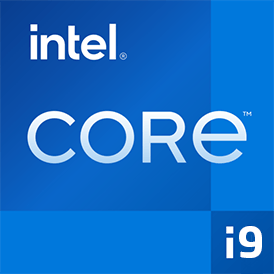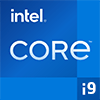
Intel Core i9

Actual generation: 14.
Actual architecture: Raptor Lake S Refresh
Technology: 10 nm
Chip design: Monolithic
Instruction set: SSE4.1, SSE4.2, AVX2, AVX2+
Virtualization: VT-x, VT-x EPT, VT-d
Since 2017, the Intel Core i9 processors have stood for maximum performance in the end customer segment. The Intel Core i9 processors have even more cores than Intel's previous top series, the Core i7. In addition, the Intel Core i9 processors have an even higher clock frequency. In order to enable the high clock rates, only the best chips are used in the Intel Core i9 series.Actual architecture: Raptor Lake S Refresh
Technology: 10 nm
Chip design: Monolithic
Instruction set: SSE4.1, SSE4.2, AVX2, AVX2+
Virtualization: VT-x, VT-x EPT, VT-d
The Intel Core i9 processors have high basic clock rates, which can be significantly increased again in Turbo mode. Since these are very powerful processors, both notebooks and desktop PCs or workstations must be cooled very well in order not to limit the full performance of the processors. Otherwise, so-called thermal throttling occurs, in which the processor automatically reduces its clock frequency as soon as a certain core temperature is reached.
Since 2021, Intel has relied on a hybrid core structure for its processors, in which fast P cores calculate with efficient but slower E cores in a network. With this structure, Intel has been able to significantly increase the number of cores in its processors in recent years and thus again achieve the TOP positions in benchmarks such as Cinebench R23, even in very heavy load scenarios.
All Intel Core i9 processors with a K or KF in the product designation can be overclocked, there are even mobile processors with a free multiplier. These can be recognized by a final HK in the product designation. Since 2019, Intel has also been offering the so-called F variants, in which the internal graphics card (iGPU) is deactivated. In return, the processors are available at a reduced price. Everyone has to decide for themselves whether it's worth it. However, one should consider that the integrated graphics unit can also be used for video playback, e.g. on YouTube, Netflix or Amazon Prime Video. The dedicated graphics card can then be put into standby there, which has a positive effect on energy consumption.
Competitor AMD has been countering the Intel Core i9 processors with the Ryzen 9 processors since the end of 2019, which are currently available with up to 16 cores (AMD Ryzen 9 7950X) in the mainstream desktop area. The Intel processors are manufactured in a process called Intel 7 (improved 10 nm process), which is said to be roughly comparable to TSMC's 7 nm production. Technically, the current Intel processors are roughly on the same level as the AMD models, with a slight advantage for AMD, whose current models are already manufactured in 5 nm.
The Intel Core i9 processors can manage at least 128 GB of RAM in at least two memory channels (dual-channel mode). The latest Intel Core i9 processors (Raptor Lake) support up to DDR5-5600 RAM. Using the Intel XMP 3.0 profile, even faster memory modules can be installed in order to further increase the bandwidth of the processor.
All Intel Core i9 CPUs
| Processor | Generation | ||
 |
Intel Core i9-14900T 24C 32T @ 1.10 GHz |
14. | |
 |
Intel Core i9-14900KS 24C 32T @ 3.20 GHz |
14. | |
 |
Intel Core i9-14900KF 24C 32T @ 3.20 GHz |
14. | |
 |
Intel Core i9-14900K 24C 32T @ 3.20 GHz |
14. | |
 |
Intel Core i9-14900HX 24C 32T @ 2.20 GHz |
14. | |
 |
Intel Core i9-14900F 24C 32T @ 2.00 GHz |
14. | |
 |
Intel Core i9-14900 24C 32T @ 2.00 GHz |
14. | |
 |
Intel Core i9-13980HX 24C 32T @ 2.20 GHz |
13. | |
 |
Intel Core i9-13950HX 24C 32T @ 2.20 GHz |
13. | |
 |
Intel Core i9-13905H 14C 20T @ 2.60 GHz |
13. | |
 |
Intel Core i9-13900TE 24C 32T @ 1.00 GHz |
13. | |
 |
Intel Core i9-13900T 24C 32T @ 1.10 GHz |
13. | |
 |
Intel Core i9-13900KS 24C 32T @ 3.20 GHz |
13. | |
 |
Intel Core i9-13900KF 24C 32T @ 3.00 GHz |
13. | |
 |
Intel Core i9-13900K 24C 32T @ 3.00 GHz |
13. | |
 |
Intel Core i9-13900HX 24C 32T @ 2.20 GHz |
13. | |
 |
Intel Core i9-13900HK 14C 20T @ 2.60 GHz |
13. | |
 |
Intel Core i9-13900H 14C 20T @ 2.60 GHz |
13. | |
 |
Intel Core i9-13900F 24C 32T @ 2.00 GHz |
13. | |
 |
Intel Core i9-13900E 24C 32T @ 1.80 GHz |
13. |
Intel Core i9 generation list
| Name | Generation | Segment | Technology | Architecture |
| Intel Core i 14000 | 14. | Desktop / Server | 10 nm | Raptor Lake S Refresh |
| Intel Core i 14000H | 14. | Mobile | 10 nm | Raptor Lake H Refresh |
| Intel Core i 13000 | 13. | Desktop / Server | 10 nm | Raptor Lake S |
| Intel Core i 13000H | 13. | Mobile | 10 nm | Raptor Lake H |
| Intel Core i 12000 | 12. | Desktop / Server | 10 nm | Alder Lake S |
| Intel Core i 12000H | 12. | Mobile | 10 nm | Alder Lake H |
| Intel Core i 11000H | 11. | Mobile | 10 nm | Tiger Lake H |
| Intel Core i 11000 | 11. | Desktop / Server | 14 nm | Rocket Lake S |
| Intel Core i 10000 | 10. | Desktop / Server | 14 nm | Comet Lake S |
| Intel Core i 10000H | 10. | Mobile | 14 nm | Comet Lake H |
| Intel Core i 10000X | 10. | Desktop / Server | 14 nm | Cascade Lake |
| Intel Core i 9000 | 9. | Desktop / Server | 14 nm | Coffee Lake S Refresh |
| Intel Core i 9000H | 9. | Mobile | 14 nm | Coffee Lake H Refresh |
| Intel Core i 9000X | 9. | Desktop / Server | 14 nm | Skylake X Refresh |
| Intel Core i 8000H | 8. | Mobile | 14 nm | Coffee Lake H |
| Intel Core i 7000X | 7. | Desktop / Server | 14 nm | Skylake X |
back to index



